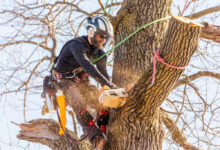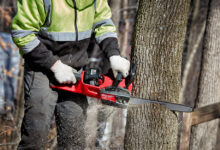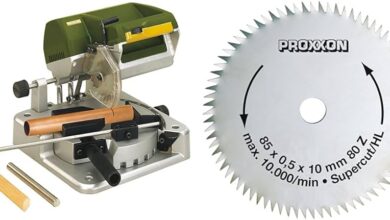Contents
Introductory Words
Embarking on the task of replacing your chainsaw chain may initially seem like a daunting endeavor. However, with meticulous preparation and a systematic approach, you can transform this chore into a rewarding experience. Whether you’re a seasoned chainsaw enthusiast or a novice venturing into the realm of chainsaw maintenance, this comprehensive guide will provide you with the essential knowledge and techniques to ensure a successful chainsaw chain replacement.
By delving into the intricate details of chain replacement, you’ll gain invaluable insights into the inner workings of your chainsaw. You’ll come to appreciate the importance of proper chain selection, the intricacies of tensioning and lubrication, and the satisfaction of restoring your chainsaw to its former slicing and dicing glory.
Let’s embark on this journey of discovery, empowering you with the knowledge and skills necessary to tackle chainsaw chain replacement with confidence.
Introduction
1. The heart of your chainsaw’s cutting prowess lies within the intricate workings of its chain. Maintaining a sharp, undamaged chain is paramount to ensuring optimal performance and preventing unnecessary strain on the machine’s motor. Over time, wear and tear will inevitably take their toll on the chain, necessitating its replacement.
2. Replacing a chainsaw chain is a task that requires meticulous attention to detail and a thorough understanding of the specific requirements of your chainsaw model. By following the steps outlined in this guide, you can ensure that the replacement process is executed seamlessly, minimizing the risk of damage to your chainsaw or personal injury.
3. To achieve a successful chainsaw chain replacement, it’s essential to select the correct chain type and size for your chainsaw model. Mismatched chains can cause improper cutting, premature wear, and potential damage to the chainsaw’s drive components.
4. Proper tensioning of the chainsaw chain is crucial for ensuring both safety and efficiency. An overly loose chain can derail during operation, posing a significant safety hazard. Conversely, a chain that is too tight will increase friction, strain the motor, and accelerate chain wear.
5. Adequate lubrication is the lifeblood of a chainsaw chain, extending its lifespan and maintaining optimal cutting performance. Neglecting proper lubrication can lead to rapid chain wear, increased friction, and potential damage to the chainsaw’s guide bar.
6. Sharpening a chainsaw chain is an essential maintenance task that should be performed regularly to maintain optimal cutting efficiency. Dull chains require more effort to cut, increase wear on the chain and guide bar, and can lead to kickback, a dangerous phenomenon that can occur when the chainsaw suddenly jerks backward.
7. Recognizing the signs of a worn-out chainsaw chain is crucial for preventing costly damage to your chainsaw and ensuring safe operation. Ignoring these signs can lead to excessive wear on other chainsaw components, reduced cutting efficiency, and potential safety hazards due to chain breakage.
Strengths of Chainsaw Chain Replacement Tips
1. Enhanced Cutting Performance: A properly replaced chainsaw chain will restore your chainsaw’s cutting capabilities to their peak, allowing you to tackle tough cutting jobs with ease and efficiency.
2. Extended Chainsaw Lifespan: Regular chain replacement helps to prevent premature wear and tear on the chainsaw’s motor, guide bar, and other components, prolonging the lifespan of your valuable tool.
3. Improved Safety: A properly tensioned and lubricated chain reduces the risk of derailment and kickback, enhancing the overall safety of your chainsaw operation.
Weaknesses of Chainsaw Chain Replacement Tips
1. Time-Consuming: Replacing a chainsaw chain requires time and attention to detail, especially if you’re not familiar with the process.
2. Costly: High-quality chainsaw chains can be expensive, especially for larger models.
3. Safety Concerns: Replacing a chainsaw chain involves handling sharp objects and moving parts, which can pose safety hazards if proper precautions are not taken.
Complete Information about Chainsaw Chain Replacement Tips
| Essential Steps | Detailed Explanation |
|---|---|
| Selecting the Correct Chain | Choosing the right chain size and type for your chainsaw ensures optimal performance and prevents damage. Refer to your chainsaw’s user manual for specific chain recommendations. |
| Replacing the Chain | Follow the steps outlined in this guide to safely remove the old chain and install the new one. Ensure that the chain is properly tensioned and lubricated. |
| Sharpening the Chain | Regular sharpening is essential for maintaining optimal cutting efficiency. Use a chainsaw sharpener or file to sharpen the chain teeth according to the manufacturer’s instructions. |
| Tensioning the Chain | Properly tensioning the chain is crucial for safety and performance. Refer to your chainsaw’s user manual for specific tensioning instructions. |
| Lubricating the Chain | Regular lubrication extends the life of the chain and reduces friction. Use a high-quality chainsaw chain oil and follow the manufacturer’s instructions for application. |
| Replacing the Guide Bar and Sprocket | If the guide bar or sprocket is damaged, replace them to ensure optimal chain performance and prevent premature wear. |
| Maintaining the Chain | Regular maintenance, including cleaning, sharpening, and lubrication, will extend the life of your chainsaw chain and ensure optimal performance. |
Frequently Asked Questions
1. What are the signs of a worn-out chainsaw chain?
2. How often should I replace my chainsaw chain?
3. What are the benefits of using a high-quality chainsaw chain?
4. How do I tension my chainsaw chain properly?
5. What type of lubricant should I use for my chainsaw chain?
6. How do I sharpen my chainsaw chain?
7. What are the safety precautions I should take when replacing my chainsaw chain?
8. Can I replace my chainsaw chain with a different size or type?
9. What tools do I need to replace my chainsaw chain?
10. How do I dispose of my old chainsaw chain?
11. How can I extend the lifespan of my chainsaw chain?
12. What are some common mistakes to avoid when replacing a chainsaw chain?
13. Can I replace my chainsaw chain myself, or should I take it to a professional?
Conclusion
1. By following the detailed instructions provided in this comprehensive guide, you’re well-equipped to tackle chainsaw chain replacement with confidence.
2. Remember that proper chain selection, tensioning, lubrication, and sharpening are key to ensuring optimal chainsaw performance and longevity.
3. Embracing regular maintenance practices, including cleaning, sharpening, and lubrication, will extend the life of your chainsaw chain and ensure that your chainsaw is always ready to conquer your cutting tasks.
4. Maintaining a sharp chain not only enhances cutting efficiency but also minimizes the strain on the chainsaw’s motor, reducing fuel consumption and extending the lifespan of your valuable tool.
5. By investing in a high-quality chainsaw chain and adhering to proper maintenance practices, you’ll maximize the performance of your chainsaw and minimize the need for frequent replacements, saving you time and money in the long run.
6. Always prioritize safety when working with chainsaws or performing chainsaw maintenance. Wear appropriate safety gear, including gloves, eye protection, and hearing protection, and follow all safety instructions carefully.
7. Embark on your chainsaw chain replacement journey with confidence, knowing that you possess the knowledge and skills to restore your chainsaw to its peak cutting performance.
Closing Words
Embracing proper chainsaw chain replacement techniques is a testament to your commitment to maintaining your valuable tool and ensuring its longevity. By consistently implementing the practices outlined in this guide, you’ll not only enhance the cutting capabilities of your chainsaw but also safeguard its integrity, preventing costly repairs and ensuring years of reliable service.









